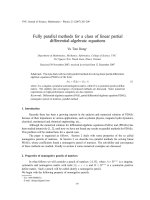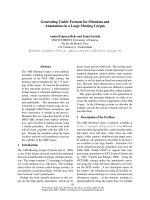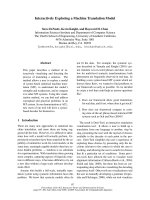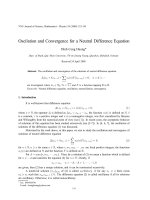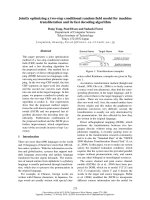Báo cáo " Oscilation and Convergence for a Neutral Difference Equation " pptx
Bạn đang xem bản rút gọn của tài liệu. Xem và tải ngay bản đầy đủ của tài liệu tại đây (176.97 KB, 11 trang )
VNU Journal of Science, Mathematics - Physics 24 (2008) 133-143
Oscilation and Convergence for a Neutral Difference Equation
Dinh Cong Huong*
Dept. of Math, Quy Nhon University 170 An Duong Vuong, Quynhon, Binhdinh, Vietnam
Received 24 April 2008
Abstract. The oscillation and convergence of the solutions of neutral difference equation
∆(x
n
+ δx
n−τ
) +
r
i=1
α
i
(n)F (x
n−m
i
) = 0, n = 0, 1, · · ·
are investigated, where m
i
∈ N
0
, ∀i =
1, r and F is a function mapping R to R.
Keyworks: Neutral difference equation, oscillation, nonoscillation, convergence.
1. Introduction
It is well-known that difference equation
∆(x
n
+ δx
n−τ
) + α(n)x
n−σ
= 0, (1)
where n ∈ N, the operator ∆ is defined as ∆x
n
= x
n+1
− x
n
, the function α(n) is defined on N, δ
is a constant, τ is a positive integer and σ is a nonnegative integer, was first considered by Brayton
and Willoughby from the numerical point of view (see [1]). In recent years, the asymptotic behavior
of solutions of this equation has been studied extensively (see [2-7]). In [4, 6, 7], the oscillation of
solutions of the difference equation (1) was discussed.
Motivated by the work above, in this paper, we aim to study the oscillation and convergence of
solutions of neutral difference equation
∆(x
n
+ δx
n−τ
) +
r
i=1
α
i
(n)F (x
n−m
i
) = 0, (2)
for n ∈ N, n a for some a ∈ N, where r, m
1
, m
2
, · · · , m
r
are fixed positive integers, the functions
α
i
(n) are defined on N and the function F is defined on R.
Put A = max{τ, m
1
, · · · , m
r
}. Then, by a solution of (2) we mean a function which is defined
for n −A and sastisfies the equation (2) for n ∈ N. Clearly, if
x
n
= a
n
, n = −A, −A + 1, · · · , −1, 0
are given, then (2) has a unique solution, and it can be constructed recursively.
A nontrivial solution {x
n
}
na
of (2) is called oscillatory if for any n
1
a there exists
n
2
n
1
such that x
n
2
x
n
2
+1
0. The difference equation (2) is called oscillatory if all its solutions
are oscillatory. Otherwise, it is called nonoscillatory.
∗
Tel.: 0984769741
E-mail:
133
134 D.C. Huong / VNU Journal of Science, Mathematics - Physics 24 (200 8) 133-143
2. Main results
2.1. The Oscillation
Consider neutral difference equation
∆(x
n
+ δx
n−τ
) +
r
i=1
α
i
(n)x
n−m
i
= 0, (3)
for n ∈ N, n a for some a ∈ N, where r, m
1
, m
2
, · · · , m
r
are fixed positive integers and the
functions α
i
(n) are defined on N. It is clear that equation (3) is a particular case of (2). We shall
establish some sufficient criterias for the oscillation of solutions of the difference equation (3). First
of all we have
Theorem 1. Assume tha t
( ˜m + 1)
˜m+1
˜m
˜m
r
i=1
lim inf
n→∞
α
i
(n) > 1, (4)
where δ = 0, α
i
(n) 0, n ∈ N, 1 i r and ˜m = min
1ir
m
i
. Then, (3) is os ci llat ory.
Proof. We first prove that the inequality
∆x
n
+
r
i=1
α
i
(n)x
n−m
i
0, n ∈ N (5)
has no eventually positive solution. Assume, for the sake of contradiction, that (5) has a solution {x
n
}
with x
n
> 0 for all n n
1
, n
1
∈ N. Setting v
n
=
x
n
x
n+1
and dividing this inequality by x
n
, we obtain
1
v
n
1 −
r
i=1
α
i
(n)
m
i
ℓ=1
v
n−ℓ
, (6)
where n n
1
+ m, m = max
1ir
m
i
.
Clearly, {x
n
} is nonincreasing with n n
1
+ m, and so v
n
1 for all n n
1
+ m. From (4)
and (6) we see that {v
n
} is a above bounded sequence. Putting lim inf
n→∞
v
n
= β, we get
lim sup
n→∞
1
v
n
=
1
β
1 − lim inf
n→∞
r
i=1
α
i
(n)
m
i
ℓ=1
v
n−ℓ
,
or
1
β
1 −
r
i=1
lim inf
n→∞
α
i
(n) · β
m
i
. (7)
Since
β
m
i
β
˜m
, ∀i =
1, r,
we have
lim inf
n→∞
α
i
(n)β
m
i
lim inf
n→∞
α
i
(n)β
˜m
, ∀i =
1, r
and
1 −
r
i=1
lim inf
n→∞
α
i
(n)β
m
i
1 −
r
i=1
lim inf
n→∞
α
i
(n)β
˜m
.
D.C. Huong / VNU Journal of Science, Mat hematics - Physics 24 (2008) 133-143 135
From (7) we have
lim inf
n→∞
r
i=1
α
i
(n)
β − 1
β
˜m+1
.
But
β − 1
β
˜m+1
˜m
˜m
( ˜m + 1)
˜m+1
,
so
( ˜m + 1)
˜m+1
˜m
˜m
r
i=1
lim inf
n→∞
α
i
(n) 1,
which contradicts condition (4). Hence, (5) has no eventually positive solution.
Similarly, we can prove that the inequality
∆x
n
+
r
i=1
α
i
(n)x
n−m
i
0, n ∈ N
has no eventually negative solution. So, the proof is complete.
Corollary. Assume tha t
r
r
i=1
lim inf
n→∞
α
i
(n)
1
r
>
ˆm
ˆm
( ˆm + 1)
ˆm+1
, (8)
where δ = 0, α
i
(n) 0, n ∈ N, 1 i r and ˆm =
1
r
r
i=1
m
i
. Then, (3) is oscillator y.
Proof. We will prove that the inequality (5) has no eventually positive solution. Assume, for the sake
of contradiction, that (5) has a solution {x
n
} with x
n
> 0 for all n n
1
, n
1
∈ N. Using arithmetic
and geometric mean inequality, we obtain
r
i=1
lim inf
n→∞
α
i
(n) · β
m
i
r
r
i=1
lim inf
n→∞
α
i
(n)β
m
i
1
r
,
which is the same as
r
i=1
lim inf
n→∞
α
i
(n) · β
m
i
r
r
i=1
lim inf
n→∞
α
i
(n)
1
r
β
ˆm
.
This yields
1 −
r
i=1
lim inf
n→∞
α
i
(n) · β
m
i
1 − r
r
i=1
lim inf
n→∞
α
i
(n)
1
r
β
ˆm
.
By using the inequality (7) we have
r
r
i=1
(li m i nf
n→∞
α
i
(n))
1
r
ˆm
ˆm
( ˆm + 1)
ˆm+1
,
which contradicts condition (8). Hence, (5) has no eventually positive solution.
Next, we consider the equation (3) in case δ = 0. We have the following Lemma.
Lemma 1. Let α
i
(n) 0 for all n ∈ N and let {x
n
} be an eventually positive solution of (3). Put
z
n
= x
n
+ δx
n−τ
, we have
136 D.C. Huong / VNU Journal of Science, Mathematics - Physics 24 (200 8) 133-143
• (a) If −1 < δ < 0, t hen z
n
> 0 and ∆z
n
< 0 eventually.
• (b) If δ < −1 and
∞
ℓ=1
[
r
i=1
α
i
(ℓ)] = ∞, then z
n
< 0 and ∆z
n
0 eventually.
Proof. (a) Since α
i
(n) ≡ 0, we have
∆z
n
= −
r
i=1
α
i
(n)x
n−m
i
< 0
eventually, so z
n
cannot be eventually identically zero. If z
n
< 0 eventually, then
z
n
z
N
< 0, ∀n N ∈ N.
Since −1 < δ < 0, we get
z
n
= x
n
+ δx
n−τ
> x
n
− x
n−τ
,
which implies that
x
n
< z
n
+ x
n−τ
z
N
+ x
n−τ
.
Therefore,
x
N+τn
< z
N
+ x
N+τn−τ
= z
N
+ x
N+τ(n−1)
< · · · < nz
N
+ x
N
.
Taking n → ∞ in the above inequality, we have x
N+τn
< 0, which is a contradiction to x
n
> 0.
(b) We have
∆z
n
= −
r
i=1
α
i
(n)x
n−m
i
< 0,
for n sufficient large. We shall prove that z
n
< 0, eventually. Assume, for the sake of a contradiction,
that
z
n
= x
n
+ δx
n−τ
0, n N,
i.e.
x
n
−δx
n−τ
, n N,
which implies that
0 < x
N−τ
−
1
δ
x
N
· · ·
−
1
δ
j
x
N+(j−1)τ
, j = 1, 2, · · · .
On letting j → ∞ in the above inequality, we get x
n
→ ∞ as n → ∞. But
∆z
n
= −
r
i=1
α
i
(n)x
n−m
i
−M
r
i=1
α
i
(n), (9)
for n sufficient large, where M > 0. Summing (9) from N to n, we obtain
z
n+1
− z
N
−M
n
ℓ=N
[
r
i=1
α
i
(ℓ)] ,
which implies that z
n
→ −∞ as n → ∞. This contradicts the hypothesis that z
n
0, n N.
Theorem 2. Suppose that
1
1 + δ
( ˜m + 1)
˜m+1
˜m
˜m
r
i=1
lim inf
n→∞
α
i
(n) > 1, (10)
D.C. Huong / VNU Journal of Science, Mat hematics - Physics 24 (2008) 133-143 137
where −1 < δ < 0, ˜m = min
1ir
m
i
and α
i
(n) 0, α
i
(n) > α
i
(n − τ), for n sufficient large,
1 i r. Then, (3) is oscil latory.
Proof. Assume the contrary and let {x
n
} be an eventually positive solution of (3). Let z
n
= x
n
+δx
n−τ
and w
n
= z
n
+ δz
n−τ
. Then, by the case (a) of Lemma 1, z
n
> 0, ∆z
n
< 0 and w
n
> 0. We have
∆w
n
= ∆z
n
+ δ∆z
n−τ
= −
r
i=1
α
i
(n)x
n−m
i
− δ
r
i=1
α
i
(n − τ )x
n−τ−m
i
,
−
r
i=1
α
i
(n)x
n−m
i
− δ
r
i=1
α
i
(n)x
n−τ−m
i
,
∆w
n
−
r
i=1
α
i
(n)(x
n−m
i
+ δx
n−τ−m
i
),
∆w
n
−
r
i=1
α
i
(n)z
n−m
i
0.
Putting lim
n→∞
z
n
= β, we have β 0 and
lim
n→∞
w
n
= β + δβ = (1 + δ)β 0.
Therefore, w
n
> 0 for n sufficient large. On the other hand,
w
n
= z
n
+ δz
n−τ
(1 + δ)z
n
,
which implies that
z
n−m
i
w
n−m
i
1 + δ
.
Hence, we obtain
∆w
n
−
r
i=1
α
i
(n)z
n−m
i
−
1
1 + δ
r
i=1
α
i
(n)w
n−m
i
,
or
∆w
n
+
1
1 + δ
r
i=1
α
i
(n)w
n−m
i
0. (11)
By Theorem 1 and in view of condition (10), the inequality (11) has no eventually positive
solution, which is a contradiction.
Lemma 2. Assume that −1 < δ < 0 and τ > ˜m + 1, where ˜m = min
1ir
m
i
. Then, the maximum
value of f(β) =
β−1
β
˜m+2
(1 + δβ
τ
) on [1, ∞) is f (β
∗
), in which β
∗
∈ (1, (−δ)
−1/τ
) is a unique real
solution of the equation
1 + δβ
τ
+ (β − 1)[δτβ
τ
− ( ˜m + 1)(1 + δβ
τ
)] = 0.
Proof. The equation f
′
(β) = 0 is equivalent to
1 + δβ
τ
+ (β − 1)[δτβ
τ
− ( ˜m + 1)(1 + δβ
τ
)] = 0. (12)
138 D.C. Huong / VNU Journal of Science, Mathematics - Physics 24 (200 8) 133-143
Put
ϕ(β) = 1 + δβ
τ
+ (β − 1)[δτβ
τ
− ( ˜m + 1)(1 + δβ
τ
)].
It is easy to check that
ϕ
′
(β) = δτβ
τ −1
+ δβ
τ
[τ − ( ˜m + 1)] − ( ˜m + 1) + (β − 1)δτβ
τ −1
[τ − ( ˜m + 1)].
Since τ > ˜m + 1, we get ϕ
′
(β) < 0. On the other hand, we have ϕ(1) = 1 + δ > 0 and
lim
β→+∞
ϕ(β) = lim
β→+∞
{1 + δβ
τ
+ (β − 1)[δβ
τ
[τ − ( ˜m + 1)] − ( ˜m + 1)]} = −∞.
It implies that, ϕ is a decreasing function, starting from a positive value at β = 1, and hence (12)
has a unique real solution β
∗
∈ [1, ∞). Further, it is easy to see that β
∗
∈ (1, (−δ)
−1/τ
) and
f(β) 0, ∀β ∈ (1, (−δ)
−1/τ
), which implies that f (β
∗
) is the maximum value of f (β) on [1, ∞).
The proof is complete
Theorem 3. Assume that −1 < δ < 0; τ > ˜m + 1; α
i
(n) 0, α
i
(n) > α
i
(n − τ ),
for n suffi ci ent large, 1 i r, ˜m = min
1ir
m
i
and
r
i=1
lim inf
n→∞
α
i
(n) >
β
∗
− 1
β
∗
˜m+2
(1 + δβ
∗
τ −1
), (13)
where β
∗
∈ [1, ∞) is defined as in Lemma 2. Then, (3) is oscillatory.
Proof. Suppose to the contrary, and let {x
n
} be an eventually positive solution of (3). By the case (a)
of Lemma 1, we get z
n
> 0, ∆z
n
< 0 eventually. On the other hand,
∆w
n
= ∆( z
n
+ δz
n−τ
) −
r
i=1
α
i
(n)z
n−m
i
0. (14)
Putting γ
n
=
z
n−1
z
n
, we have γ
n
1 for n sufficient large. Dividing (14) by z
n
, we get
1
γ
n+1
1 + δ
z
n−τ
z
n
−
z
n−τ+1
z
n
−
r
i=1
α
i
(n)
z
n−m
i
z
n
,
or
1
γ
n+1
1 + δ
γ
n−τ+1
· · ·γ
n
− γ
n−τ+2
· · · γ
n
−
r
i=1
α
i
(n)
m
i
ℓ=0
γ
n−ℓ
. (15)
Setting lim inf
n→∞
γ
n
= β, we get β 1. It is clear that β is finite. From (15) we have
lim sup
n→∞
1
γ
n+1
=
1
β
1 + δβ
τ −1
(β − 1) −
r
i=1
lim inf
n→∞
α
i
(n) · β
m
i
,
r
i=1
lim inf
n→∞
α
i
(n) · β
m
i
+1
1 + δβ
τ −1
(β − 1) −
1
β
= (β − 1)[
1
β
+ δβ
τ −1
],
r
i=1
lim inf
n→∞
α
i
(n)
β − 1
β
˜m+2
(1 + δβ
τ
) = f(β).
D.C. Huong / VNU Journal of Science, Mat hematics - Physics 24 (2008) 133-143 139
By Lemma 2, we have
r
i=1
lim inf
n→∞
α
i
(n) f(β
∗
) =
β
∗
− 1
β
∗
˜m+2
(1 + δβ
∗
τ
),
which contradicts condition (13). Hence, (3) has no eventually positive solution.
Theorem 4. Suppose that
−
1
δ + 1
(τ − m
∗
)
τ −m
∗
(τ − m
∗
− 1)
τ −m
∗
−1
r
i=1
lim inf
n→∞
α
i
(n) > 1, (16)
where α
i
(n) α
i
(n − τ) for n sufficient large; δ < −1, m
∗
= ma x
1ir
m
i
, τ > m
∗
+ 1 and
∞
ℓ=1
[
r
i=1
α
i
(ℓ)] = ∞. Then, (3) is oscillatory.
Proof. Assume the contrary. Without loss of generality, let {x
n
} be an eventually positive solution of
(3). By the case (b) of Lemma 1, we have z
n
< 0 and ∆z
n
0. Putting
w
n
= z
n
+ δz
n−τ
,
we have
w
n
= z
n
+ δz
n−τ
(1 + δ)z
n−τ
,
which is the same as
z
n−τ
1
δ + 1
w
n
.
Therefore, it follows that
∆w
n
= ∆z
n
+ δ∆z
n−τ
= −
r
i=1
α
i
(n)x
n−m
i
− δ
r
i=1
α
i
(n − τ )x
n−τ−m
i
,
−
r
i=1
α
i
(n)x
n−m
i
− δ
r
i=1
α
i
(n)x
n−τ−m
i
,
∆w
n
−
r
i=1
α
i
(n)(x
n−m
i
+ δx
n−τ−m
i
),
∆w
n
−
r
i=1
α
i
(n)z
n−m
i
0,
so we get
0 ∆w
n
+
r
i=1
α
i
(n)z
n−m
i
∆w
n
+
1
δ + 1
r
i=1
α
i
(n)w
n−m
i
+τ
.
Setting γ
n
=
w
n+1
w
n
, we obtain
γ
n
1 −
1
δ + 1
r
i=1
α
i
(n)
τ −m
i
ℓ=1
γ
n−m
i
+τ−ℓ
. (17)
140 D.C. Huong / VNU Journal of Science, Mathematics - Physics 24 (200 8) 133-143
Putting β = lim inf
n→∞
γ
n
, we have β 1. Taking lower limit on both sides of (17), we obtain
β 1 −
1
δ + 1
r
i=1
lim inf
n→∞
α
i
(n) · β
τ −m
i
,
or
β − 1 −
1
δ + 1
r
i=1
lim inf
n→∞
α
i
(n) · β
τ −m
i
. (18)
Since
β
τ −m
i
β
τ −m
∗
, ∀i =
1, r,
−
1
δ + 1
lim inf
n→∞
α
i
(n)β
τ −m
i
−
1
δ + 1
lim inf
n→∞
α
i
(n)β
τ −m
∗
, ∀i =
1, r.
From (18) we get
−
1
δ + 1
r
i=1
lim inf
n→∞
α
i
(n)
β − 1
β
τ −m
∗
.
But
β − 1
β
τ −m
∗
(τ − m
∗
− 1)
τ −m
∗
−1
(τ − m
∗
)
τ −m
∗
,
so
−
1
δ + 1
(τ − m
∗
)
τ −m
∗
(τ − m
∗
− 1)
τ −m
∗
−1
r
i=1
lim inf
n→∞
α
i
(n) 1,
which contradicts condition (16). Hence, (3) has no eventually positive solution.
Theorem 5. Suppose that
−
1
δ
(τ − m
∗
)
τ −m
∗
(τ − m
∗
− 1)
τ −m
∗
−1
r
i=1
lim inf
n→∞
α
i
(n) > 1, (19)
where δ < −1, m
∗
= max
1ir
m
i
, τ > m
∗
+ 1 and
∞
ℓ=1
[
r
i=1
α
i
(ℓ)] = ∞. Then, (3) is oscilla tory.
Proof. Suppose to the contrary, and let {x
n
} be an eventually positive solution of (3). Put z
n
=
x
n
+ δx
n−τ
. By the case (b) of Lemma 1, we obtain z
n
< 0 and ∆z
n
0. On the other hand, we
have z
n
> δx
n−τ
or x
n−τ
>
1
δ
z
n
, which implies that x
n−m
i
>
1
δ
z
n+τ−m
i
. Hence,
∆z
n
−
1
δ
r
i=1
α
i
(n)z
n+τ−m
i
. (20)
Setting v
n
=
z
n+1
z
n
and dividing (20) by z
n
, we obtain
v
n
1 −
1
δ
r
i=1
α
i
(n)
z
n+τ−m
i
z
n
,
or
v
n
1 −
1
δ
r
i=1
α
i
(n)
τ −m
i
−1
ℓ=0
z
n+τ−m
i
−ℓ
z
n+τ−m
i
−ℓ−1
. (21)
D.C. Huong / VNU Journal of Science, Mat hematics - Physics 24 (2008) 133-143 141
Taking lower limit on both sides of (21) and putting β = lim inf
n→∞
v
n
, we have β 1 and
β − 1 −
1
δ
r
i=1
lim inf
n→∞
α
i
(n) · β
τ −m
i
.
We can prove
−
1
δ
(τ − m
∗
)
τ −m
∗
(τ − m
∗
− 1)
τ −m
∗
−1
r
i=1
lim inf
n→∞
α
i
(n) 1
similarly as the proof of Theorem 4, which contradicts condition (19). Hence, (3) has no eventually
positive solution.
2.2. The Convergence
We give conditions implying that every nonoscillatory solution is convergent. To begin with,
we have
Lemma 3. Let {x
n
} be a nonosci llat ory solution of (2). Put z
n
= x
n
+ δx
n−τ
.
• (a) If {x
n
} is eventually positive (negative), then {z
n
} is eventually nonincreasing (nonde-
creasing).
• (b) If {x
n
} is eventually positive (negative) and there exists a con stant γ such that
−1 < γ δ, (22)
then eventually z
n
> 0 (z
n
< 0).
Proof. Let {x
n
} be an eventually positive solution of (2). The case {x
n
} is an eventually negative
solution of (2) can be considered similarly.
(a) We have ∆z
n
= −
r
i=1
α
i
(n)F (x
n−m
i
) 0 for all large n. Thus, {z
n
} is eventually
nonincreasing.
(b) Suppose the conclusion does not hold, then since by (a) {z
n
} is nonincreasing, it follows
that eventually either z
n
≡ 0 or z
n
< 0. Now z
n
≡ 0 implies that ∆z
n
= −
r
i=1
α
i
(n)F (x
n−m
i
) ≡ 0,
but this contradicts the fact that α
i
(n) ≡ 0 for infinitely many n. If z
n
< 0, then x
n
< −δx
n−τ
so
δ < 0. From (22) it follows that −1 < γ < 0 and x
n
< −γx
n−τ
. Thus, by induction, we obtain
x
n+jτ
(−γ)
j
x
n
for all positive integers j. Hence, x
n
→ 0 as n → ∞. It implies that {z
n
} decreases
to zero as n → ∞. This contradicts the fact that z
n
< 0.
Theorem 6. Assume that
∞
ℓ=1
r
i=1
α
i
(ℓ) = ∞, (23)
and there exists a constant η such that
−1 < η δ 0. (24)
Suppos e further that, if |x| c th en |F(x)| c
1
where c and c
1
are positi ve constants. Then, every
nonoscillatory solution of (2) tends to 0 as n → ∞.
142 D.C. Huong / VNU Journal of Science, Mathematics - Physics 24 (200 8) 133-143
Proof. Let {x
n
} be an eventually positive solution of (2), say x
n
> 0, x
n−τ
> 0 and x
n−m
i
> 0 for
n n
0
∈ N. Put z
n
= x
n
+δx
n−τ
. We first prove that z
n
→ 0 as n → ∞. Note that (24) implies (22)
with γ replace by η. By Lemma 3 we have {z
n
} is eventually positive and nonincreasing. Therefore,
there exists lim
n→∞
z
n
. Put lim
n→∞
z
n
= β. Now, suppose that β > 0. By (24), we have z
n
x
n
. Thus,
there exists an integer n
1
n
0
∈ N such that
β z
n−m
i
x
n−m
i
, ∀n n
1
, i = 1, · · · , r.
Hence,
∆z
n
= −
r
i=1
α
i
(n)F (x
n−m
i
) −M
r
i=1
α
i
(n), ∀n n
1
for some positive constant M. Summing the last inequality, we obtain
z
n
z
n
1
− M
n−1
ℓ=n
1
r
i=1
α
i
(ℓ),
which as n → ∞, in view of (23), implies that z
n
→ −∞. This is a contradiction.
Since lim
n→∞
z
n
= 0, there exists a positive constant A such that 0 < z
n
A and so, by (24) we
have
x
n
−ηx
n−τ
+ A. (25)
Assume that {x
n
} is not bounded. Then, there exists a subsequence {n
k
} of N, so that lim
k→∞
x
n
k
= ∞
and x
n
k
= max
n
0
jn
k
x
j
, k = 1, 2, · · · . From (25), for k sufficiently large, we get
x
n
k
−ηx
n
k
+ A
and so
(1 + η)x
n
k
A,
which as k → ∞ leads to a contradiction.
Now suppose that lim sup
n→∞
x
n
= α > 0. Then, there exists a subsequence {n
k
} of N, with n
1
large enough so that x
n
> 0 for n > n
1
− τ and x
n
k
→ α as k → ∞. Then, from (24), we have
z
n
k
x
n
k
+ ηx
n
k
−τ
and so
x
n
k
−τ
−
1
η
(x
n
k
− z
n
k
).
As k → ∞, we obtain
α lim
k→∞
x
n
k
−τ
−
α
η
.
Since −η ∈ (0, 1), it follows that α = 0, i.e. x
n
→ 0 as n → ∞. The arguments when {x
n
} is an
eventually negative solution of (2) is similar.
Theorem 7. Suppose there exists positi ve const ants M , α
i
, i = 1, 2, · · · , r such that
α
i
(n) α
i
, i = 1, 2, · · · , r, ∀n ∈ N, (26)
|F (x)| M|x|, ∀x ∈ R, (27)
δ 0. (28)
D.C. Huong / VNU Journal of Science, Mat hematics - Physics 24 (2008) 133-143 143
Then, every nonoscillatory solution of (2) tends to 0 as n → ∞.
Proof. Let {x
n
} be an eventually positive solution of (2), say x
n
> 0, x
n−τ
> 0 and x
n−m
i
> 0 for
n n
0
∈ N. By Lemma 3, {z
n
} is eventually positive and nonincreasing, so there exists lim
n→∞
z
n
.
Put lim
n→∞
z
n
= β. Summing the equation (2) from n to ∞ for n n
0
, we obtain
z
n
= β +
∞
ℓ=n
r
i=1
α
i
(ℓ)F (x
ℓ−m
i
), n n
0
.
Now by (26) and (27), we get
αM
∞
ℓ=n
r
i=1
α
i
(ℓ)x
ℓ−m
i
∞
ℓ=n
r
i=1
α
i
(ℓ)F (x
ℓ−m
i
) z
n
− β < ∞,
which implies that x
n
→ 0 as n → ∞. The proof is similar when {x
n
} is eventually negative.
References
[1] R. K. Brayton and R. A. Willoughby, On the numerical intagration of a symetric system of difference differential
equations of neutral type, J. Math. Anal. Appl, Vol. 18 (1967).
[2] L. H. Huang and J. S. Ju, Asymptotic behavior of solutions for a class of difference equation, J. Math. Anal. Appl., Vol.
204 (1996).
[3] I. G. E. Kordonis and C. G. Philos, Oscillation of neutral difference equation with periodic coefficients, Computer s.
Math. Applic. Vol. 33 (1997).
[4] B. S. Lalli and B. G. Zhang and J. Z. Li, On the oscillation of solutions and existence of positive solutions of neutral
delay difference equation, J . Math. Anal. Appl. Vol. 158 (1991).
[5] B. S. Lalli and B. G. Zhang, On existence of positive solutions bounded oscillations for neutral delay difference equation,
J. Math. Anal. Appl. Vol. 166 (1992).
[6] B. S. Lalli and B. G. Zhang, Oscillation and comparison theorems for certain neutral delay difference equation, J.
Aus.tral. Math. Soc. Vol. 34 (1992).
[7] B. S. Lalli, Oscillation theorems for certain neutral delay difference equation, Computers. Math. Appl. Vol. 28 (1994).
